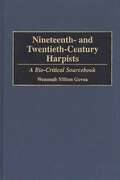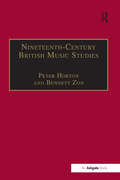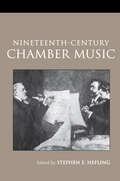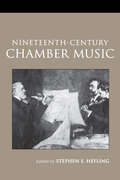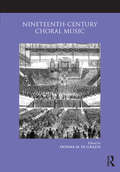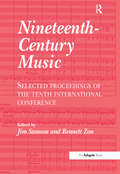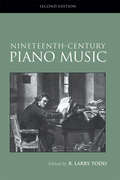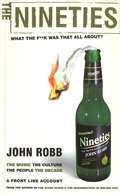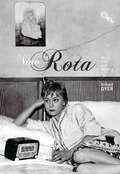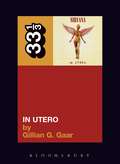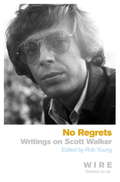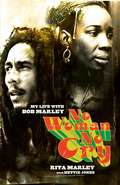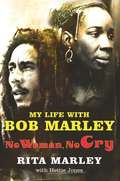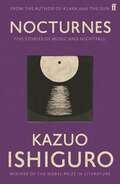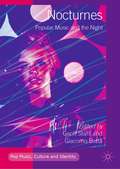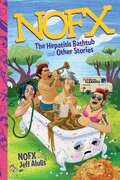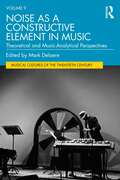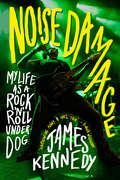- Table View
- List View
Nineteenth- and Twentieth-Century Harpists: A Bio-Critical Sourcebook (Bio-Critical Sourcebooks on Musical Performance)
by Wenonah M. GoveaThe harp is both the oldest and the newest of instruments. It has existed in some form in nearly all cultures since man has made music. The contemporary concert instrument has been known since the mid-19th century. This work is a compendium of the biographies of many notable harpists of the modern era. The biographies make clear how these performers shaped the contrasts in style and technique of harp playing that have developed over the past 150 years, as cultural, social, and psychological forces influenced individual performance. In addition to the biographical information, the A-Z entries include critical reviews, discographies, and selected bibliographies where possible. New material from the former Soviet states is included.
Nineteenth-Century British Music Studies: Volume 3
by Peter HortonSelected from papers given at the third biennial conference on Music in Nineteenth-Century Britain, this volume, in common with its two predecessors, reflects the interdisciplinary character of the topic. The introductory essay by Julian Rushton foregrounds some of the questions that are key to this area of study: what is the nineteenth century? what is British music? and did London influence the continent? The essays which follow are divided into broad thematic groups covering aspects of gender, church music, national identity, and local and national institutions. This collection illustrates that while nineteenth-century British music studies is still in its infancy as a field of research, it is one that is burgeoning and contributing to our understanding of British social and cultural life of the period.
Nineteenth-Century British Music Studies: Volume 3
by Peter HortonSelected from papers given at the third biennial conference on Music in Nineteenth-Century Britain, this volume, in common with its two predecessors, reflects the interdisciplinary character of the topic. The introductory essay by Julian Rushton foregrounds some of the questions that are key to this area of study: what is the nineteenth century? what is British music? and did London influence the continent? The essays which follow are divided into broad thematic groups covering aspects of gender, church music, national identity, and local and national institutions. This collection illustrates that while nineteenth-century British music studies is still in its infancy as a field of research, it is one that is burgeoning and contributing to our understanding of British social and cultural life of the period.
Nineteenth-Century Chamber Music
by Stephen HeflingFirst Published in 2004. Routledge is an imprint of Taylor & Francis, an informa company.
Nineteenth-Century Chamber Music
by Stephen HeflingFirst Published in 2004. Routledge is an imprint of Taylor & Francis, an informa company.
Nineteenth-Century Choral Music
by Donna M. Di GraziaNineteenth-Century Choral Music is an in-depth examination of the rich repertoire of choral music and the cultural phenomenon of choral music making throughout the period. The book is divided into three main sections. The first details the attraction to choral singing and the ways it was linked to different parts of society, and to the role of choral voices in the two principal large-scale genres of the period: the symphony and opera. A second section highlights ten choral-orchestral masterworks that are a central part of the repertoire. The final section presents overview and focus chapters covering composers, repertoire (both small and larger works), and performance life in an historical context from over a dozen regions of the world: Britain and Ireland, the Czech Republic, France, Germany, Hungary, Italy, Latin America, the Philippines, Poland, Russia, Scandinavia and Finland, Spain, and the United States. This diverse collection of essays brings together the work of 25 authors, many of whom have devoted much of their scholarly lives to the composers and music discussed, giving the reader a lively and unique perspective on this significant part of nineteenth-century musical life.
Nineteenth-Century Choral Music
by Donna M. Di GraziaNineteenth-Century Choral Music is an in-depth examination of the rich repertoire of choral music and the cultural phenomenon of choral music making throughout the period. The book is divided into three main sections. The first details the attraction to choral singing and the ways it was linked to different parts of society, and to the role of choral voices in the two principal large-scale genres of the period: the symphony and opera. A second section highlights ten choral-orchestral masterworks that are a central part of the repertoire. The final section presents overview and focus chapters covering composers, repertoire (both small and larger works), and performance life in an historical context from over a dozen regions of the world: Britain and Ireland, the Czech Republic, France, Germany, Hungary, Italy, Latin America, the Philippines, Poland, Russia, Scandinavia and Finland, Spain, and the United States. This diverse collection of essays brings together the work of 25 authors, many of whom have devoted much of their scholarly lives to the composers and music discussed, giving the reader a lively and unique perspective on this significant part of nineteenth-century musical life.
Nineteenth-Century Music: Selected Proceedings of the Tenth International Conference
by Jim SamsonThis selection of essays represents a wide cross-section of the papers given at the Tenth International Conference on Nineteenth-Century Music held at the University of Bristol in 1998. Sections include thematic groupings of work on musical meaning, Wagner, Liszt, musical culture in France, music and nation, and women and music.
Nineteenth-Century Music: Selected Proceedings of the Tenth International Conference
by Jim Samson Bennett ZonThis selection of essays represents a wide cross-section of the papers given at the Tenth International Conference on Nineteenth-Century Music held at the University of Bristol in 1998. Sections include thematic groupings of work on musical meaning, Wagner, Liszt, musical culture in France, music and nation, and women and music.
Nineteenth-Century Piano Music
by R. Larry ToddFirst Published in 2004. Routledge is an imprint of Taylor & Francis, an informa company.
Nineteenth-Century Piano Music
by R. Larry ToddFirst Published in 2004. Routledge is an imprint of Taylor & Francis, an informa company.
The Nineties: What the F**ck Was That All About?
by John RobbIF YOU REMEMBER THE NINETIES...YOU WERE THERE!The Rock 'N' Roll Fifties. The Swinging Sixties. The trashy Seventies. The money-grabbing Eighties. There is a neat bunch of clichés for every era, but THE NINETIES...What the f**k was that all about?John Robb takes us on a personal odyssey through the definitive pop cultural moments that shaped the decade in the UK.
Nino Rota: Music, Film and Feeling
by Richard DyerNino Rota is one of the most important composers in the history of cinema. Both popular and prolific, he wrote some of the most cherished and memorable of all film music – for The Godfather Parts I and II, The Leopard, the Zeffirelli Shakespeares, nearly all of Fellini and for more than 140 popular Italian movies. Yet his music does not quite work in the way that we have come to assume music in film works: it does not seek to draw us in and identify, nor to overwhelm and excite us. In itself, in its pretty but reticent melodies, its at once comic and touching rhythms, and in its relation to what's on screen, Rota's music is close and affectionate towards characters and events but still restrained, not detached but ironically attached.In this major new study of Rota's film career, Richard Dyer gives a detailed account of Rota's aesthetic, suggesting it offers a new approach to how we understand both film music and feeling and film more broadly. He also provides a first full account in English of Rota's life and work, linking it to notions of plagiarism and pastiche, genre and convention, irony and narrative. Rota's practice is related to some of the major ways music is used in film, including the motif, musical reference, underscoring and the difference between diegetic and non-diegetic music, revealing how Rota both conforms to and undermines standard conceptions. In addition, Dyer considers the issue of gay cultural production, Rota's favourte genre, comedy, and his productive collaboration with the director Federico Fellini.
Nirvana's In Utero (33 1/3)
by Gillian G. GaarThough Nevermind was Nirvana's most commercially successful album, and the record that broke them - and the grunge phenomenon - internationally, In Utero has increasingly become regarded as the band's best album, both by the critics and the band members themselves. Instead of sticking to the "grunge pop" formula that made Nevermind so palatable to the mainstream, Nirvana chose instead to challenge their audience, producing an album that the band's creative force, Kurt Cobain, said truly matched his vision of what he had always wanted his band to sound like. Here, the full story behind the creation of In Utero is told for the first time.
Nirvana's In Utero (33 1/3)
by Gillian G. GaarThough Nevermind was Nirvana's most commercially successful album, and the record that broke them - and the grunge phenomenon - internationally, In Utero has increasingly become regarded as the band's best album, both by the critics and the band members themselves. Instead of sticking to the "grunge pop" formula that made Nevermind so palatable to the mainstream, Nirvana chose instead to challenge their audience, producing an album that the band's creative force, Kurt Cobain, said truly matched his vision of what he had always wanted his band to sound like. Here, the full story behind the creation of In Utero is told for the first time.
No Regrets: Writings on Scott Walker
by Rob YoungA colourful collection of pieces on the enigmatic genius of Scott Walker from THE WIRE.Scott Walker has travelled from teen idol to the outer limits of music. From 'The Sun Ain't Gonna Shine Any More' reaching No.1, through to recordings of meat being punched on his last album, THE DRIFT, he somehow seems to have reached a passionate and committed fan base. Throughout his career, his impeccable critical reputation as a serious and uncompromising musician has never been questioned. The recent film, 30TH CENTURY MAN, had a litany of stars queuing up to praise Walker: the likes of David Bowie, Damon Albarn, Jarvis Cocker, Radiohead, Johnny Marr and Sting. But despite this, in 40 years of music, there has yet to be a serious book on Scott Walker. This collection, put together by Rob Young of THE WIRE magazine, features a handful of previously published articles and newly commissioned pieces, largely drawn from the orbit of THE WIRE's writers including Ian Penman, Chris Bohn and Rob Young.
No Woman No Cry: My Life with Bob Marley
by Rita MarleyA memoir by the woman who knew Bob Marley best--his wife, Rita. Rita Marley grew up in the slums of Trench Town, Jamaica. Abandoned by her mother at a very young age, she was raised by her aunt. Music ran in Rita's family, and even as a child her talent for singing was pronounced. By the age of 18, Rita was an unwed mother, and it was then that she met Bob Marley at a recording studio in Trench Town. Bob and Rita became close friends, fell in love, and soon, she and her girlfriends were singing backup for the Wailers. At the ages of 21 and 19, Bob and Rita were married. The rest is history: Bob Marley and the Wailers set Jamaica and the world on fire. But while Rita displayed blazing courage, joy, and an indisputable devotion to her husband, life with Bob was not easy. There were his liaisons with other women--some of which produced children and were conducted under Rita's roof. The press repeatedly reported that Bob was unmarried to preserve his "image." But Rita kept her self-respect, and when Bob succumbed to cancer in 1981, she was at his side. In the years that followed, she became a force in her own right -- as the Bob Marley Foundation's spokesperson and a performer in her reggae group, the I-Three. Written with author Hettie Jones, No Woman No Cry is a no-holds-barred account of life with one of the most famous musicians of all time. In No Woman No Cry, readers will learn about the never-before-told details of Bob Marley's life, including: How Rita practiced subsistence farming when first married to Bob to have food for her family. How Rita rode her bicycle into town with copies of Bob's latest songs to sell. How Rita worked as a housekeeper in Delaware to help support her family when her children were young. Why Rita chose to befriend some of the women with whom Bob had affairs and to give them advice on rearing the children they had with Bob. The story of the attack on Bob which almost killed the two of them. Bob's last wishes, dreams, and hopes, as well as the details of his death, such as who came to the funeral (and who didn't).
No Woman No Cry: My Life With Bob Marley
by Rita Marley Hettie JonesBob Marley is the unchallenged king of reggae and one of music's great iconic figures. Rita Marley was not just his wife and the mother of four of his children but his backing singer and friend, life-long companion and soul mate. They met in Trenchtown when he was 19 and she was 18, and she was very much part of his musical career, selling his early recordings from their house in the days before Island Records signed up the Wailers. She shared the hard times and the dangers - when Bob was wounded in a gunfight before the Peace Concert, Rita was shot in the head and left for dead. Their marriage was not always easy, but Rita was the woman Bob returned to no matter where music and other women might take him, the woman who held him when he died at the age of 35. Today she sees herself as the guardian of his legacy. Full of new insights, No Woman No Cry is a unique biography of Marley by someone who understands what it meant to grow up in poverty in Jamaica, to battle racism and prejudice. It is also a moving and inspiring story of a marriage that survived both poverty and then the strains of global celebrity. 'It will surely become the definitive biographical account of the reggae guitarist-singer-songwriter who changed pop music and in the process became a leader to millions' The Times 'Rita Marley is reggae royalty . . . In her own words, this is a revealing insight into Marley's life and legacy' Daily Mirror
Nocturnes: Five Stories of Music and Nightfall (Folio Ser. #Vol. 44216)
by Kazuo IshiguroFrom the Nobel Prize-winning author of The Remains of the Day and Never Let Me GoIn Nocturnes, Kazuo Ishiguro explores the ideas of love, music and the passing of time. From the piazzas of Italy to the 'hush-hush floor' of an exclusive Hollywood hotel, the characters we encounter range from young dreamers to café musicians to faded stars, all of them at some moment of reckoning. Gentle, intimate and witty, this quintet is marked by a haunting theme: the struggle to keep alive a sense of life's romance, even as one gets older, relationships founder and youthful hope recedes.
Nocturnes: Popular Music and the Night (Pop Music, Culture and Identity)
by Geoff Stahl Giacomo BottàThe night and popular music have long served to energise one another, such that they appear inextricably bound together as trope and topos. This history of reciprocity has produced a range of resonant and compelling imaginaries, conjured up through countless songs and spaces dedicated to musical life after dark. Nocturnes: Popular Music and the Night is one of the first volumes to examine the relationship between night and popular music. Its scope is interdisciplinary and geographically diverse. The contributors gathered here explore how the problems, promises, and paradoxes of the night and music play off of one another to produce spaces of solace and sanctuary as well as underpinning strategies designed to police, surveil and control movements and bodies. This edited collection is a welcome addition to debates and discussions about the cultures of the night and how popular music plays a continuing role in shaping them.
NOFX: The Hepatitis Bathtub and Other Stories
by NOFX Jeff AlulisThe candid, hilarious, shocking, occasionally horrifying, and surprisingly moving New York Times bestselling autobiography of punk legends NOFX, their own story in their own wordsNOFX: The Hepatitis Bathtub and Other Stories is the first tell-all autobiography from one of the world's most influential and controversial punk bands. Alongside hilarious anecdotes about pranks and drunkenness and teenage failures-featuring the trademark NOFX sense of humor-the book also shares the ugliness and horror the band members experienced on the road to becoming DIY millionaires. Fans and non-fans alike will be shocked by stories of murder, suicide, addiction, counterfeiting, riots, bondage, terminal illness, the Yakuza, and pee...lots and lots of pee. Told by each of the band members (and two former members), NOFX looks back at more than thirty years of comedy, tragedy, and completely inexplicable success.
NOFX: The Hepatitis Bathtub And Other Stories
by NOFX with Jeff AlulisNOFX: The Hepatitis Bathtub and Other Stories is the first tell-all autobiography from one of the world's most influential and controversial punk bands. Alongside hilarious anecdotes about pranks and drunkenness and teenage failures-featuring the trademark NOFX sense of humor-the book also shares the ugliness and horror the band members experienced on the road to becoming DIY millionaires. Fans and non-fans alike will be shocked by the stories of murder, suicide, addiction, counterfeiting, riots, bondage, terminal illness, the Yakuza, and pee...lots and lots of pee. Told by each of the band members (and two former members), NOFX looks back at more than thirty years of comedy, tragedy, and completely inexplicable success.
Noise as a Constructive Element in Music: Theoretical and Music-Analytical Perspectives (Musical Cultures of the Twentieth Century)
by Mark DelaereMusic and noise seem to be mutually exclusive. Music is generally considered as an ordered arrangement of sounds pleasing to the ear and noise as its opposite: chaotic, ugly, aggressive, sometimes even deafening. When presented in a musical context, noise can thus act as a tool to express resistance to predominant cultural values, to society or to socioeconomic structures (including those of the music industry). The oppositional stance confirms current notions of noise as something which is destructive, a belief not only cherished by hard-core rock bands but also shared by engineers and companies developing devices to suppress or reduce noise in our daily environment. In contrast to the common opinions on noise just described, this volume seeks to explore the constructive potential of noise in contemporary musical practices. Rather than viewing noise as a ‘defect’, this volume aims at studying its aesthetic and cultural potential. Within the noise music study field, most recent publications focus on subgenres such as psychedelic post-rock, industrial, hard-core punk, trash or rave, as they developed from rock and popular music. This book includes work on avant-garde music developed in the domain of classical music as well. In addition to already well-established (social) historical and aesthetical perspectives on noise and noise music, this volume offers contributions by music analysts.
Noise as a Constructive Element in Music: Theoretical and Music-Analytical Perspectives (Musical Cultures of the Twentieth Century)
by Mark DelaereMusic and noise seem to be mutually exclusive. Music is generally considered as an ordered arrangement of sounds pleasing to the ear and noise as its opposite: chaotic, ugly, aggressive, sometimes even deafening. When presented in a musical context, noise can thus act as a tool to express resistance to predominant cultural values, to society or to socioeconomic structures (including those of the music industry). The oppositional stance confirms current notions of noise as something which is destructive, a belief not only cherished by hard-core rock bands but also shared by engineers and companies developing devices to suppress or reduce noise in our daily environment. In contrast to the common opinions on noise just described, this volume seeks to explore the constructive potential of noise in contemporary musical practices. Rather than viewing noise as a ‘defect’, this volume aims at studying its aesthetic and cultural potential. Within the noise music study field, most recent publications focus on subgenres such as psychedelic post-rock, industrial, hard-core punk, trash or rave, as they developed from rock and popular music. This book includes work on avant-garde music developed in the domain of classical music as well. In addition to already well-established (social) historical and aesthetical perspectives on noise and noise music, this volume offers contributions by music analysts.
Noise Damage: My Life as a Rock’n’Roll Underdog
by James Kennedy‘Harrowing, funny and 100% true’ Ginger WildheartThe tale that follows is not another clichéd collection of rock’n’roll debaucheries (sorry) nor is it another tired fable of triumph over adversity (you’re welcome).It’s the story of a half-deaf kid from a tiny, remote village in South Wales who was hailed as a genius by the UK’s biggest radio station and headhunted by major record labels, only for the music industry to collapse. It crashed hard, taking with it an entire generation of talented artists who would never now get their shot. CNN called it ‘music’s lost decade’.Along the way, there are goodies, baddies, gun-toting label execs, life-saving surgeons, therapy, true love, loyalty, hope, breakdowns, suicidal managers, betrayal, drummers and way too many hangovers. James Kennedy shows that the best lessons are to be learned from good losers. It really is all about the journey.Part memoir, part exposé of the music world’s murky underbelly, Noise Damage is emotional, painfully honest, funny, informative and ridiculous. It’s also a celebration of the life-changing magic of music.
